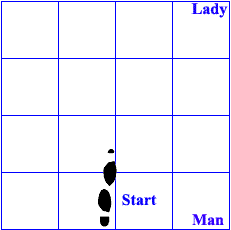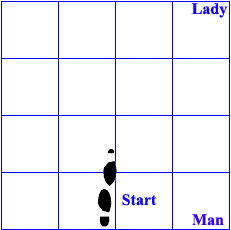
Email : [email protected] Or General Mailer
 |
Jai Chavan's
"Dance-Sport" Email : [email protected] Or General Mailer |
| Back || Master Pg. || Overview || Contents || Alphabetical Index || Home || Next |
Waltz: Basic Sequence: Part 9
| The first basic sequence. |
| Basic Sequence: | |
| 1. First Part 2. Second Part 3. Third Part 4. Fourth Part |
Reverse/Natural
Turn Hesitation Combination Under Arm Turn |
Tenth Lesson: The Final Sequence
1 First Part: Regular with continuous turns.
2. Second Part: Hesitation, and no turns here.
3. Third Part: Combination, here there’s no turn when doing
the hesitation, otherwise turn.
4. Fourth Part: Under Arm turn, with the lady going for the
underarm turn. Man does not turn. And pause for the count
"12". This will facilitate the repeating all the above
movements starting with the other foot.
Eleventh Lesson: Random-Sequence
Dancing the four parts at random and in any sequence as one
feels. This mainly helps a man to hone his skills in guiding the
lady.
The turns can be slowly increased instead of containing them to just 45 degrees.
Conclusion:
By this sequence, one would have had the general idea of the
following basic figures learned. Each of the basic figures is for
three counts.
First Part:
1. Left foot forward Close Change with Left foot moving forward
2. Right foot forward Close Change with Right foot moving forward
3. Left foot backward Close Change with Left foot moving backward
4. Right foot backward Close Change with Right foot moving
backward
First Part with turns
5. Left foot forward, First half of Reverse Turn
6. Right foot forward, First half of Natural Turn
7. Left foot backward, Second half of Natural Turn
8. Right foot backward, Second half of Reverse Turn
Second Part
9. Left foot forward and Hesitation
10. Right foot forward and Hesitation
11. Left foot backward and Hesitation
12. Right foot backward and Hesitation
13. Left foot to side and Hesitation
14. Right foot to side and Hesitation
Fourth Part Pause for one count
15. Left foot forward
16. Right foot forward
17. Left foot backward
18. Right foot backward
The basic sequence given above needs to be practised until one is able to recognise the individual figures as distinct identities. When this happens you would be able use these components and join them into a dance ad hoc when dancing to move as you like, with the mood, the need of the situation and instance.
1. Reverse Turn: 135 degrees: Pair |
Reverse Turn: (90 + 45 = 135
degrees) or (1/4 + 1/8 = 3/8 turn) 1. Man moves forward with the Left foot. Lady steps back with the Right foot. 1a. Both the feet are together however only one foot is on the floor, man’s Left foot and lady’s Right foot. Man swivels to the left on the Left ball and lady swivels to left on the Right heel. At this stage, both the partners are pulling against each other for balance, as the feet are ahead of one’s body. Achieve a 90 degrees turn here. 2. Man moves the Right foot to the side, and this is a big step to step across the lady. Lady steps on one’s Left foot close to the Right foot. 2a. Body weight shifts to the stepping foot and man’s Left foot and lady’s Right foot begin to lift off the floor. 2b. Continue the turning movement as the free foot begins to close in with the stationary foot. Turn an additional turn of 45 on the ball of Right foot (man) and Left heel (lady). 3. Replace weight on the Left foot (man) close to the Right foot, and Right foot (lady) close to the Left foot. |
2. Reverse Turn: 180 degrees: Pair |
Reverse Turn: (90 + 45 + 45 = 180
degrees) or (1/4 + 1/8 + 1/8 = 1/2 turn) 1. Man moves forward with the Left foot. Lady steps back with the Right foot. 1a. Both the feet are together and however only one foot is on the floor, man’s Left foot and lady’s Right foot. Man swivels to the left on the Left ball and lady swivels to left on the Right heel. At this stage, both the partners are pulling against each other for balance, as the feet are ahead of one’s body. Achieve a 90 degrees turn here. 2. Man moves the Right foot to the side, and this is a big step to step across the lady. Lady steps on one’s Left foot close to the Right foot. 2a. Body weight shifts to the stepping foot, and man’s Left foot and lady’s Right foot begin to lift off the floor. 2b. Continue the turning movement as the free foot begins to close in with the stationary foot. Achieve an additional turn of 45 degree on the ball of Right foot (man) and Left heel (lady). 3. Replace weight on the Left foot (man) close to the Right foot, and Right foot (lady) close to the Left foot. Continue the turning movement and get an additional turn of 45 degrees on the Left ball (man) and Right heel (lady). |
Note:
1. Generally when moving back turn on the heel of one foot and
when moving forward turn on the ball.
2. When turning the feet remain forward of the body. Thus if one
cannot stand and will fall backward if the partner will not
support with a Pull-force.
3. Whether moving backward or forward one should endeavour to
step always forward with the second step that goes across the
partner, with respect to one’s self.
4. Especially when turning, both the feet remain together
(although only one foot is on the floor) and the bodies are
consciously erect.
5. The one moving back is like a pole-support around which the
partner moving forward will hold and swing across in the
direction of the flow of the dance, which is the first step.
6. Although the figures above are for man moving forward,
he must also practise the lady’s part. Similarly, the lady
must practise the forward movement as well. In the figure above
the Finish Step is the first step of the backward movement for
the man and forward movement for the lady.
All the best and Happy Dancing.
| Back || Master Pg. || Overview || Contents || Alphabetical Index || Home || Next |